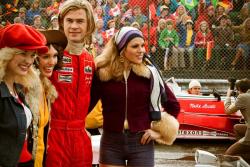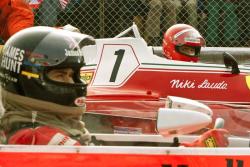Article by Brendan McAleer
Most of the time, we car reviewers are advising you how to spend thousands of dollars on something you’ll keep for years. Theoretically, it should be far easier to recommend spending twelve bucks for two hours entertainment – but this is not always the case (see: The Lone Ranger).
However, it is with great relief that I can inform you that Ron Howard’s F1 racing flick, Rush, lives up to all the internet buzz around it. It’s worth both your time and money, but before I explain why, if you’re going to see it anyway, stop reading here. Mild spoilers ahead.
 Movie Review: Rush. Click image to enlarge |
In a nutshell, the story hangs on two central characters, a dashing, devil-may-care hero and his calculating, offensive, seemingly inhuman rival. They could have called it, Captain Kirk and Mr. Spock go to the races. Halfway through, however, things are turned on their head and the audience finds themselves rooting for both men.
Chris Hemsworth, who everyone will recognize as Thor, plays lightning-fast lothario James Hunt with easy affability. Hunt’s notorious excesses are at first easy to forgive, but gradually Howard pulls the lens back and we see something of an emptiness amidst all the noise, a petulant childishness.
Brühl’s Lauda is instantly unlikeable, rat-faced and blunt of speech, but you warm to him gradually, as with all great villains. Lauda strategizes himself into a F1 driver’s seat, Hunt charms his way in.
The racing footage itself will not please everyone. F1 can often be a form of high-speed, high-stakes chess, with tension building over an entire weekend and season. Cramming all that into under two hours requires some distillation, and while much effort has been made to avoid clunky visual effects, you can’t make a movie like this without some green-screen trickery.
  Movie Review: Rush. Click image to enlarge |
What you get, instead of stark realism, is sheer excitement. V12 engines snarl, tires spin, tiny rocks ping off the drivers’ helmets, and all the while, there’s speed and sound in an incomprehensible wave. The danger is there, but you share a sense of exhilaration as the cars scream along, almost always shot from a very low angle.
Particularly during the dangerous F1 of the ’70s, death is always present at every race, and along with the joy of speed, we’re shown its disastrous after-effects: a corpse in a wrecked car, a brutal compound fracture. Hunt famously throws up before every race, a sea of roiling adrenaline; Lauda calculates his chances of dying at an acceptable 20 percent.











